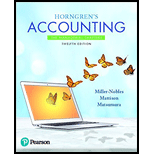
Horngren's Accounting (12th Edition)
12th Edition
ISBN: 9780134486444
Author: Tracie L. Miller-Nobles, Brenda L. Mattison, Ella Mae Matsumura
Publisher: PEARSON
expand_more
expand_more
format_list_bulleted
Concept explainers
Question
Chapter 9, Problem 12RQ
To determine
Allowance method:
The purpose of allowance method is to record the
Under Allowance method, when is bad debt recorded?
Expert Solution & Answer
Want to see the full answer?
Check out a sample textbook solution
Students have asked these similar questions
What are total assets at the end of the year?
Part 3 and part 4
Hello tutor solve my qn
Chapter 9 Solutions
Horngren's Accounting (12th Edition)
Ch. 9 - 1. With good internal controls, the person who...Ch. 9 - Which of the following is a limitation of the...Ch. 9 - 3. The entry to record a write-off of an...Ch. 9 - Brickman Company uses the allowance method to...Ch. 9 - Brickman’s ending balance of accounts Receivable...Ch. 9 - During the year, Bernard Company had net credit...Ch. 9 - At December 31 year-end, Crain Company has an...Ch. 9 - Using the data in the preceding question, what...Ch. 9 - At year-end, Schultz Company has cash of $11,600,...Ch. 9 - Using the data in the preceding question, assume...
Ch. 9 - What is the difference between accounts receivable...Ch. 9 - List some common examples of other receivables,...Ch. 9 - Prob. 3RQCh. 9 - When dealing with receivables, give an example of...Ch. 9 - What type of account must the sum of all...Ch. 9 - Prob. 6RQCh. 9 - What occurs when a business factors its...Ch. 9 - What occurs when a business pledges its...Ch. 9 - What is the expense account associated with the...Ch. 9 - When is bad debts expense recorded when using the...Ch. 9 - What are some limitations of using the direct...Ch. 9 - Prob. 12RQCh. 9 - Prob. 13RQCh. 9 - When using the allowance method, what account is...Ch. 9 - Prob. 15RQCh. 9 - Prob. 16RQCh. 9 - How do the percent-of-receivables and...Ch. 9 - What is the difference between the...Ch. 9 - In accounting for bad debts, how do the income...Ch. 9 - What is the formula to compute interest on a note...Ch. 9 - Prob. 21RQCh. 9 - Prob. 22RQCh. 9 - Prob. 23RQCh. 9 - Prob. 24RQCh. 9 - Prob. S9.1SECh. 9 - Recording credit sales and collections Learning...Ch. 9 - Applying the direct write-off method to account...Ch. 9 - Collecting a receivable previously written...Ch. 9 - Applying the allowance method to account for...Ch. 9 - Applying the allowance method (percent-of-sales)...Ch. 9 - Applying the allowance method...Ch. 9 - Applying the allowance method...Ch. 9 - Computing interest amounts on notes receivable...Ch. 9 - Accounting for a note receivable Learning...Ch. 9 - Accruing interest revenue and recording collection...Ch. 9 - Recording a dishonored note receivable Learning...Ch. 9 - Prob. S9.13SECh. 9 - Defining common receivables terms Learning...Ch. 9 - E9-15 Identifying and correcting internal control...Ch. 9 - Recording credit sales and collections Learning...Ch. 9 - Journalizing transactions using the direct...Ch. 9 - Accounting for uncollectible accounts using the...Ch. 9 - Accounting for uncollectible accounts using the...Ch. 9 - Accounting for uncollectible accounts using the...Ch. 9 - Prob. E9.21ECh. 9 - Journalizing credit sales, note receivable...Ch. 9 - Journalizing note receivable transactions...Ch. 9 - Journalizing note receivable transactions Learning...Ch. 9 - Journalizing note receivable transactions Learning...Ch. 9 - Evaluating ratio data Learning Objective 5 Abanaki...Ch. 9 - Computing the collection period for receivables...Ch. 9 - Accounting for uncollectible accounts using the...Ch. 9 - Accounting for uncollectible accounts using the...Ch. 9 - Accounting for uncollectible accounts using the...Ch. 9 - Prob. P9.31APGACh. 9 - Accounting for notes receivable and accruing...Ch. 9 - Prob. P9.33APGACh. 9 - Using ratio data to evaluate a company’s financial...Ch. 9 - Accounting for uncollectible accounts using the...Ch. 9 - Accounting for uncollectible accounts using the...Ch. 9 - Prob. P9.37BPGBCh. 9 - Prob. P9.38BPGBCh. 9 - Prob. P9.39BPGBCh. 9 - Accounting for notes receivable, dishonored notes,...Ch. 9 - Using ratio data to evaluate a company’s financial...Ch. 9 - Prob. P9.42CTCh. 9 - Prob. P9.43CPCh. 9 - Prob. P9.44PSCh. 9 - Prob. 9.1TIATCCh. 9 - Decision Case 9-1 Weddings on Demand sells on...Ch. 9 - Decision Case 9-2 Pauline’s Pottery has always...Ch. 9 - Prob. 9.1FCCh. 9 - Financial Statement Case 9-1 Use Target...
Knowledge Booster
Learn more about
Need a deep-dive on the concept behind this application? Look no further. Learn more about this topic, accounting and related others by exploring similar questions and additional content below.Similar questions
- Please help me correct the wrong answers:Depreciation expense cant be: 11k or 12,625arrow_forwardSolve this problem quarrow_forwardA company’s debt-to-equity ratio is calculated by dividing:a) Total Assets by Total Equityb) Total Liabilities by Total Equityc) Total Debt by Total Equity d) Total Revenue by Total Equityarrow_forward
arrow_back_ios
SEE MORE QUESTIONS
arrow_forward_ios
Recommended textbooks for you

 AccountingAccountingISBN:9781337272094Author:WARREN, Carl S., Reeve, James M., Duchac, Jonathan E.Publisher:Cengage Learning,
AccountingAccountingISBN:9781337272094Author:WARREN, Carl S., Reeve, James M., Duchac, Jonathan E.Publisher:Cengage Learning, Accounting Information SystemsAccountingISBN:9781337619202Author:Hall, James A.Publisher:Cengage Learning,
Accounting Information SystemsAccountingISBN:9781337619202Author:Hall, James A.Publisher:Cengage Learning, Horngren's Cost Accounting: A Managerial Emphasis...AccountingISBN:9780134475585Author:Srikant M. Datar, Madhav V. RajanPublisher:PEARSON
Horngren's Cost Accounting: A Managerial Emphasis...AccountingISBN:9780134475585Author:Srikant M. Datar, Madhav V. RajanPublisher:PEARSON Intermediate AccountingAccountingISBN:9781259722660Author:J. David Spiceland, Mark W. Nelson, Wayne M ThomasPublisher:McGraw-Hill Education
Intermediate AccountingAccountingISBN:9781259722660Author:J. David Spiceland, Mark W. Nelson, Wayne M ThomasPublisher:McGraw-Hill Education Financial and Managerial AccountingAccountingISBN:9781259726705Author:John J Wild, Ken W. Shaw, Barbara Chiappetta Fundamental Accounting PrinciplesPublisher:McGraw-Hill Education
Financial and Managerial AccountingAccountingISBN:9781259726705Author:John J Wild, Ken W. Shaw, Barbara Chiappetta Fundamental Accounting PrinciplesPublisher:McGraw-Hill Education


Accounting
Accounting
ISBN:9781337272094
Author:WARREN, Carl S., Reeve, James M., Duchac, Jonathan E.
Publisher:Cengage Learning,

Accounting Information Systems
Accounting
ISBN:9781337619202
Author:Hall, James A.
Publisher:Cengage Learning,

Horngren's Cost Accounting: A Managerial Emphasis...
Accounting
ISBN:9780134475585
Author:Srikant M. Datar, Madhav V. Rajan
Publisher:PEARSON

Intermediate Accounting
Accounting
ISBN:9781259722660
Author:J. David Spiceland, Mark W. Nelson, Wayne M Thomas
Publisher:McGraw-Hill Education

Financial and Managerial Accounting
Accounting
ISBN:9781259726705
Author:John J Wild, Ken W. Shaw, Barbara Chiappetta Fundamental Accounting Principles
Publisher:McGraw-Hill Education
Accounts Receivable and Accounts Payable; Author: The Finance Storyteller;https://www.youtube.com/watch?v=x_aUWbQa878;License: Standard Youtube License